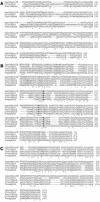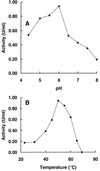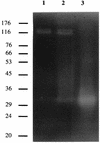Molecular and biochemical characterization of two xylanase-encoding genes from Cellulomonas pachnodae
- PMID: 10473422
- PMCID: PMC99747
- DOI: 10.1128/AEM.65.9.4099-4107.1999
Molecular and biochemical characterization of two xylanase-encoding genes from Cellulomonas pachnodae
Abstract
Two xylanase-encoding genes, named xyn11A and xyn10B, were isolated from a genomic library of Cellulomonas pachnodae by expression in Escherichia coli. The deduced polypeptide, Xyn11A, consists of 335 amino acids with a calculated molecular mass of 34,383 Da. Different domains could be identified in the Xyn11A protein on the basis of homology searches. Xyn11A contains a catalytic domain belonging to family 11 glycosyl hydrolases and a C-terminal xylan binding domain, which are separated from the catalytic domain by a typical linker sequence. Binding studies with native Xyn11A and a truncated derivative of Xyn11A, lacking the putative binding domain, confirmed the function of the two domains. The second xylanase, designated Xyn10B, consists of 1,183 amino acids with a calculated molecular mass of 124,136 Da. Xyn10B also appears to be a modular protein, but typical linker sequences that separate the different domains were not identified. It comprises a N-terminal signal peptide followed by a stretch of amino acids that shows homology to thermostabilizing domains. Downstream of the latter domain, a catalytic domain specific for family 10 glycosyl hydrolases was identified. A truncated derivative of Xyn10B bound tightly to Avicel, which was in accordance with the identified cellulose binding domain at the C terminus of Xyn10B on the basis of homology. C. pachnodae, a (hemi)cellulolytic bacterium that was isolated from the hindgut of herbivorous Pachnoda marginata larvae, secretes at least two xylanases in the culture fluid. Although both Xyn11A and Xyn10B had the highest homology to xylanases from Cellulomonas fimi, distinct differences in the molecular organizations of the xylanases from the two Cellulomonas species were identified.
Figures







Similar articles
-
Evidence for temporal regulation of the two Pseudomonas cellulosa xylanases belonging to glycoside hydrolase family 11.J Bacteriol. 2002 Aug;184(15):4124-33. doi: 10.1128/JB.184.15.4124-4133.2002. J Bacteriol. 2002. PMID: 12107129 Free PMC article.
-
Evidence for a general role for high-affinity non-catalytic cellulose binding domains in microbial plant cell wall hydrolases.Mol Microbiol. 1994 Jan;11(2):375-82. doi: 10.1111/j.1365-2958.1994.tb00317.x. Mol Microbiol. 1994. PMID: 8170399
-
A modular xylanase from mesophilic Cellulomonas fimi contains the same cellulose-binding and thermostabilizing domains as xylanases from thermophilic bacteria.FEMS Microbiol Lett. 1996 May 15;139(1):27-35. doi: 10.1111/j.1574-6968.1996.tb08175.x. FEMS Microbiol Lett. 1996. PMID: 8647371
-
Evidence for synergy between family 2b carbohydrate binding modules in Cellulomonas fimi xylanase 11A.Biochemistry. 2001 Feb 27;40(8):2468-77. doi: 10.1021/bi002564l. Biochemistry. 2001. PMID: 11327868
-
Structure and function analysis of Pseudomonas plant cell wall hydrolases.Prog Nucleic Acid Res Mol Biol. 1998;61:211-41. doi: 10.1016/s0079-6603(08)60828-4. Prog Nucleic Acid Res Mol Biol. 1998. PMID: 9752722 Review.
Cited by
-
Identification and characterization of the three chitin-binding domains within the multidomain chitinase Chi92 from Aeromonas hydrophila JP101.Appl Environ Microbiol. 2001 Nov;67(11):5100-6. doi: 10.1128/AEM.67.11.5100-5106.2001. Appl Environ Microbiol. 2001. PMID: 11679332 Free PMC article.
-
The quest for a unified view of bacterial land colonization.ISME J. 2014 Jul;8(7):1358-69. doi: 10.1038/ismej.2013.247. Epub 2014 Jan 23. ISME J. 2014. PMID: 24451209 Free PMC article.
-
Novel GH10 xylanase, with a fibronectin type 3 domain, from Cellulosimicrobium sp. strain HY-13, a bacterium in the gut of Eisenia fetida.Appl Environ Microbiol. 2009 Nov;75(22):7275-9. doi: 10.1128/AEM.01075-09. Epub 2009 Sep 18. Appl Environ Microbiol. 2009. PMID: 19767466 Free PMC article.
-
Identification and characterization of novel cellulolytic and hemicellulolytic genes and enzymes derived from German grassland soil metagenomes.Biotechnol Lett. 2012 Apr;34(4):663-75. doi: 10.1007/s10529-011-0830-2. Epub 2011 Dec 21. Biotechnol Lett. 2012. PMID: 22187078 Free PMC article.
-
The highly differentiated gut of Pachnoda marginata hosts sequential microbiomes: microbial ecology and potential applications.NPJ Biofilms Microbiomes. 2024 Jul 31;10(1):65. doi: 10.1038/s41522-024-00531-7. NPJ Biofilms Microbiomes. 2024. PMID: 39085298 Free PMC article.
References
-
- Bayon C, Mathelin J. Carbohydrate fermentation and by-product adsorption studied with labelled cellulose in Oryctes nasicornis larvae (Coleoptera: Scrarabaeidae) J Insect Physiol. 1980;26:833–840.
-
- Bhalerao J, Patki A H, Bhave M, Khurana I, Deobagkar D N. Molecular cloning and expression of a xylanase gene from Cellulomonas sp. into Escherichia coli. Appl Microbiol Biotechnol. 1990;34:71–76.
-
- Cazemier A E, Op den Camp H J M, Hackstein J H P, Vogels G D. Fibre digestion in arthropods. Comp Biochem Physiol. 1997;118A:101–109.
-
- Cazemier, A. E., H. J. M. Op den Camp, J. C. Verdoes, J. H. P. Hackstein, and G. D. Vogels. Cellulomonas pachnodae sp. nov., a member of the (hemi)cellulolytic hindgut flora of larvae of the scarab beetle Pachnoda marginata. Submitted for publication. - PubMed
Publication types
MeSH terms
Substances
Associated data
- Actions
- Actions
LinkOut - more resources
Full Text Sources
Other Literature Sources

